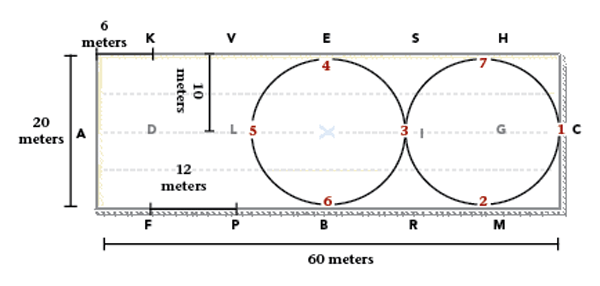
Last month we covered the 20-by-60 dressage arena, its letter markers and the 20-meter circle. Now that you have had a month to practice, you should be more than ready to move on to more advanced exercises that incorporate what you have learned. One of the easiest ways to do this is to add changes of direction to your 20-meter circles. Introduce this concept with 20-meter figure eights (20-meter circle to 20-meter circle) and you will find that your homework from last month really pays off.
The other good news is that if circles are the equine equivalent of reaching above your head and bending sideways to stretch one side of your body, consider figure eights to be a complete Jane Fonda-style stretching routine. As you change from one direction to the other, your horse must bend one way (stretching the outer side of his body), straighten and then bend the other way (stretching the other side). Try the figure eight yourself to better understand how this works:
Recall that a large dressage arena is 20 meters wide and 60 meters long. The 20-meter figure eight will take up the full width and two-thirds of the length. Looking at our illustration of the figure eight, you may notice that the exercise is just a combination of two of the 20-meter circles we reviewed last month. Let us review the steps to ride the circle and then add the steps for the figure eight to better understand how to transition between the exercises with ease:
1. On the right rein, begin at point 1 (marked by the letter C).
2. Ride a slightly sloped line aimed at the track (point 2), 10 meters from the corner between C and M. This point from the corner is 4 meters past M and 8 meters before R.
3. Ride a sloped line to point 3, 20 meters down the centerline from C—2 meters past I.
4. To ride your figure eight, straighten your horse parallel to the short side of the arena at point 3 for a few strides. Turn onto the left rein and aim for point 4—the letter E.
5. Ride a sloped line to point 5—2 meters before the letter L.
6. Continue to point 6—the letter B.
7. Return to point 3—2 meters past I (in relation to C). Notice that you have just ridden a full 20-meter circle in the center of the arena.
8. Return to your original 20-meter circle at the end by riding parallel to the short side for two strides at point 3. Change onto the right rein again.
9. Ride a sloped line to point 7—8 meters farther than S, as you are approaching. Again, the point you arrive on the track should be 4 meters before the corner letter (this time H).
10. Finish your circle by returning to point 1 at C.
A key aspect of this exercise is straightening your horse as you cross over centerline (the imaginary line that connects A to C). By riding parallel to the short side at that moment, you can prevent him from falling into the turn.
The important thing is that your horse is benefiting from the stretch and bend of the circle, so careful geometry will keep you from riding an infinity sign instead.
Practice this along with your 20-meter circles and you will be ready to ride correct serpentines when we introduce them next month.
This article originally appeared in the February 2014 issue of Dressage Today as part of a monthly series on Dressage 101 topics in the 2014 issues.
In addition to her role as contributing editor at the magazine, Hilary Moore Hebert is also a professional dressage trainer with clients from green to FEI. A USDF bronze and silver medalist, as well as “L” Education Program graduate, she owns and operates Moore Hebert Dressage at Alsikkan Farm in Germantown, Maryland.












